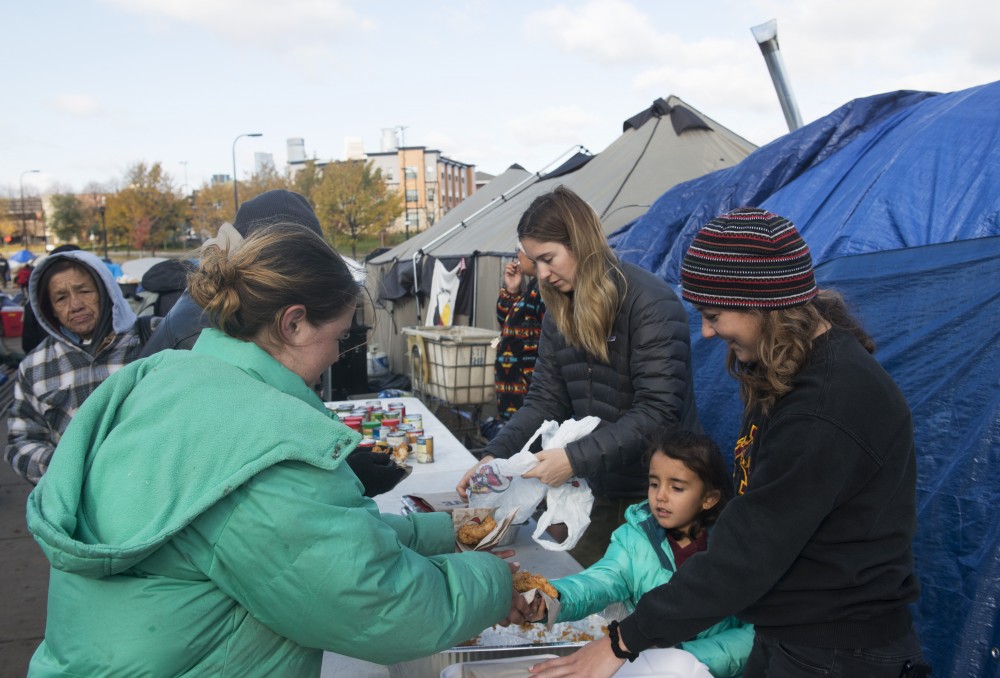Two miles from the University of Minnesota campus, a homeless community has taken refuge within rows of tents alongside a highway wall.
The makeshift homes line Franklin and Hiawatha avenues outside the Cedar-Riverside neighborhood and have collectively been dubbed the “Wall of Forgotten Natives” for the encampment’s large population of American Indians. Many have a myriad of reasons for how they ended up at the Wall, but all residents face significant barriers to stable housing.
On Sunday morning, camp was beginning to awaken. Residents, including families and children, milled about. When University graduate student Kristina Tester arrived carrying an armful of chicken, they greeted her with a smile.
Ellen Eagle Tail, a Natives Against Heroin volunteer, looked on as residents lined up for breakfast. Although the line seems fairly long, there are many more in the camp, said Eagle Tail. According to the camp blog’s last count, there are 207 tents at the site. After about 15 minutes, the food was gone.
Eagle Tail and her husband are at the Wall nearly every day, distributing food and supplies and patrolling the camp at night. “It’s like a big family,” she said. “The first time I drove out here, I cried.”
Tester, who is studying for her law and medical degrees, said she met many residents while interning at the Native American Community Clinic and doing clean needle exchanges. While affordable medical help is available at NACC and other nearby clinics, getting medical care to the homeless battling addiction can be difficult.
“Even though there’s a really low barrier to entry … people are afraid of getting arrested or having their kids getting taken away. They don’t trust the system very much,” said Tester. “As it gets colder, the worry is that people will start overdosing in their tents. During the summer it’s easier to be outside and you can spot people that go down on the street.”
Tester said all patients struggling with addiction deserve support and housing, regardless of whether or not they can achieve sobriety.
“The fact of the matter is there will always be a portion of the population that struggles with addiction and may not be able to be sober … and they still need care and deserve care,” Tester said.
After breakfast, residents fall into their daily routine. Desi Gokey, who also goes by the spirit name Flying Around Thunderbird, has resided at the Wall for a month and often helps out with various tasks.
“That’s what keeps my sobriety, to continue being a service for the people,” said Gokey, who was previously a spiritual advisor.
The highs and lows of the camp are extreme. Gokey said when he arrived, two people were found near the bathrooms suffering from overdose. With that grim reality in mind, he does what he can to keep busy every day.
“I’m here because I hope to get a home too,” he said. “One thing about being on the street is you’re starving all the time … it’s hard when you go to bed cold, and it’s wet, and you wake up and it’s cold and wet.”
Earlier this month, the City of Minneapolis agreed to provide $1.5 million in funding to create temporary shelter for the Wall residents, such as trailers. The structures are expected to open in early December. In the meantime, efforts by various community organizations are underway to prepare the camp for the colder months ahead.
University student group Women for Political Change collected donations of winter gear and camping supplies last week.
“We started doing this … because we realized there’s nothing really on campus supporting what’s going on there,” said WFPC President Aurin Chowdhury.
The encampment especially needs supplies like firewood and tarps, which are hard to come by on campus.
Camille Gage, who runs the Franklin-Hiawatha camp blog for the Metropolitan Urban Indian Directors, said she hopes students and faculty will address homelessness on a deeper level.
“Don’t just bring your old clothes to the camp. Get involved with changing housing policy … learn about it, tell others about the issues underlying why this is happening,” said Gage.








